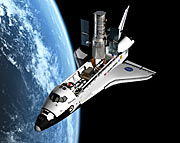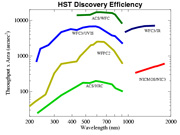Hubble Servicing Mission 4
With the decision by NASA’s Administrator Michael Griffin to carry on with the launch of a fifth Servicing Mission to upgrade the outer space Hubble Space Telescope in August of 2008, a crew of NASA astronauts as well as a team of controllers will receive two years of training that will prepare them for the, presumably, final mission to the telescope. Despite the Columbia Space Shuttle disaster in 2003 and the absence of a safe haven for the crew, NASA’s approval for the 11-day mission will not only ensure that Hubble can function for perhaps as much as another ten years, but it will also increase its capabilities significantly in key areas. Once launched, the Atlantis Space Shuttle will follow an orbit tilted 28.5 degrees to the Earth’s equator on a path that will ensure that the space vehicle makes contact with Hubble around three days after launch. The connection between the shuttle and Hubble will take place in an orbit 589 km above the Earth. Due to Hubble’s orbit around the Earth, it will not be possible for the crew to refuge in the International Space Station if the shuttle was, for instance, damaged at launch. The mission will feature five spacewalks during the flight, which will be performed by two different teams of spacewalkers on alternative days. The mission was originally planned to upgrade the telescope by installing two new scientific instruments: the Cosmic Origins Spectrograph (COS) replacing a no-longer used instrument called COSTAR, and the Wide Field Camera 3 (WFC3 replacing the current WFC2. Each has advanced technology sensors that will dramatically improve Hubble’s potential for discovery and enable it to observe the faint light from the youngest stars and galaxies in the Universe. However, the failure of Hubble’s main camera - the Advanced Camera for Surveys - on 27 January 2007 has made this mission even more invaluable to the future of Hubble. ACS’s failure by an electrical glitch has curtailed the flow of high-resolution imagery from Hubble until 2008. The installation of the WFC3 and the repair of Hubble’s spectrographic instrument will replace and increase the lost power of the ACS. The crew will also try to repair Hubble’s broken Space Telescope Imaging Spectrograph (STIS). Such a complex task, considered to be the most challenging repair job since the replacement of a power control unit in 2002, will entail the removal of 111 non-captive screws and the replacement of a power supply circuit board. Additionally, Hubble will witness the installation of a cooling system to lower the spectrometer’s temperature and the repair of its thermal insulation. Moreover, the astronauts will install a fixture enabling the attachment of a small rocket module to drop the observatory safely out of orbit when it ceases to be operational. Other upgrades will include the installation of several pallets in the shuttle’s cargo bay:
Service mission 4 will also see the arrival of a completely new camera at Hubble. An IMAX 3D camera will fly aboard the Space Shuttle recording Hubble’s servicing mission for an IMAX 3D space film. With such an astounding increase in its science capabilities, Hubble will continue to penetrate the most distant corners of space and reveal further breathtaking phenomena.
Links |
New Servicing Mission to upgrade instruments .
Here is shown the relative "discovery efficiencies" of the current Hubble cameras and the WFC3. It is seen that in the ultraviolet and infrared Hubble will have nearly a ten-fold increase in "discovery efficiency" (light throughput times field of view). In the visible the ACS camera will remain the main camera. |

